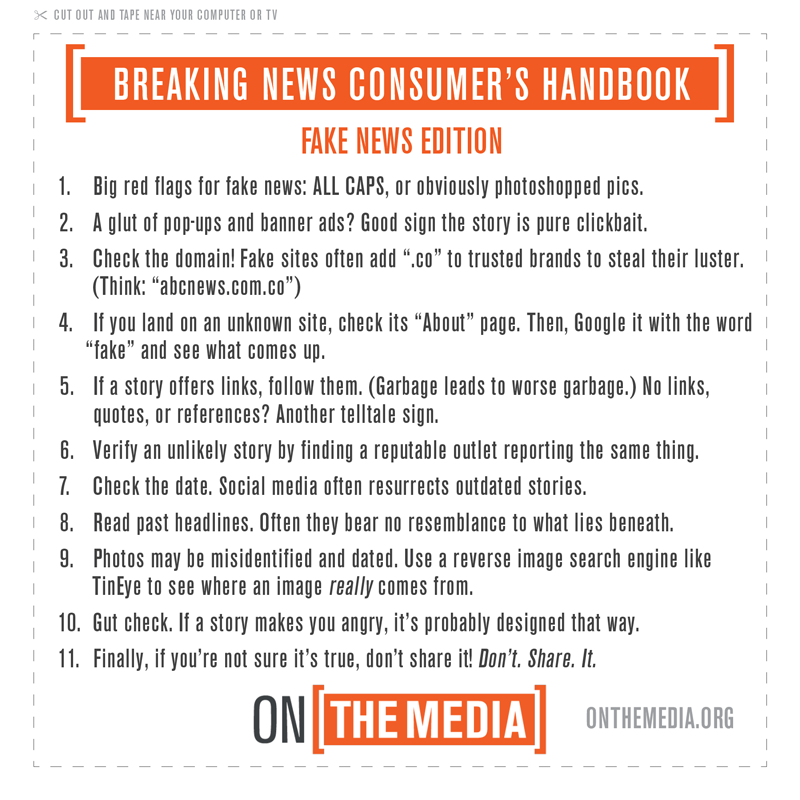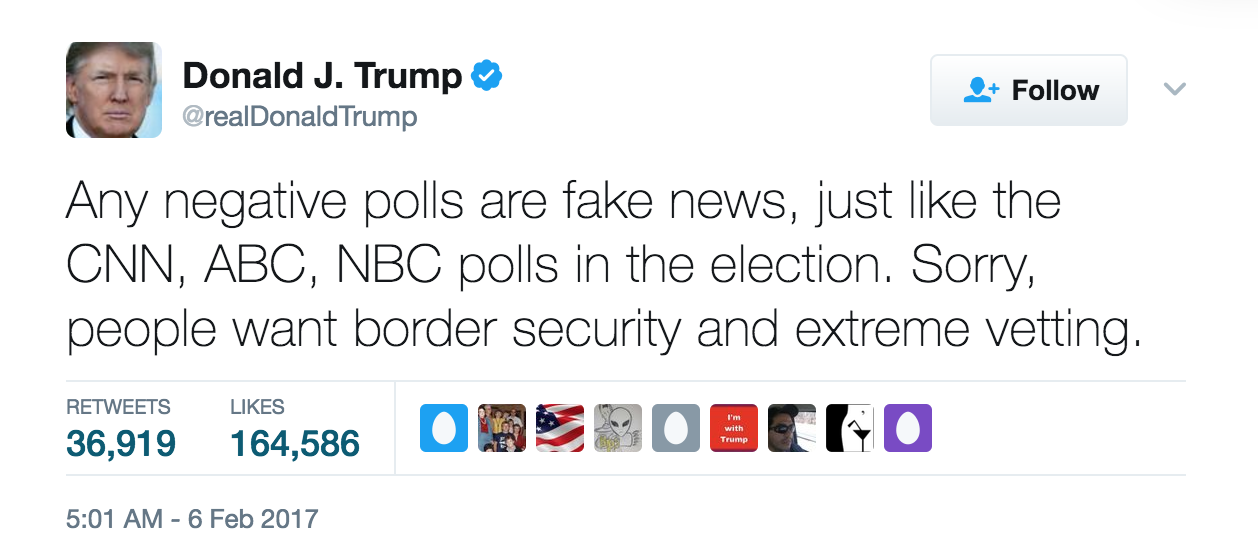Fake news presents a challenge to the public
The “fake news invasion” has many people not knowing what to believe and not trusting the media
March 11, 2017
The phenomenon known as “fake news” heated up during the recent election cycle. Fake news has no definable meaning except that President Donald Trump makes allegations that various news agencies and reporters are disseminating “fake news” but for the most part the actual “fake” part of fake news encompasses disinformation, propaganda and publishing hoaxes in what appears to be news writing. During the election it was everywhere online from Facebook threads to even reliable news sources reposting an unverifiable, too-good-to-be-true story and unfortunately these fictional stories are still circulating. Fake news can be convincing to the untrained eye but can have serious repercussions and reactions on the people who read and more importantly, believe the stories.
The National Enquirer and News of the World are tabloids that have been in grocery store checkout lines for decades, but fake news has now emerged as something that can influence and propagate instantaneously. The Washington Post reported on Edgar Welch walking into a North Carolina pizzeria armed with an A-R 15 assault rifle, expecting to investigate a widespread, election-related conspiracy theory about a VIP child-sex ring in the restaurant. Welch found no children when he stormed into the restaurant and he admitted that “the intel wasn’t 100%.” It once seemed incredible that a fictitious story of this nature could cause a man to walk into a family restaurant armed, but things like this do happen, they are happening and in frightening numbers today thanks to the mass spreading, sharing and clicking on fake news articles.
Throughout President Donald Trump’s campaign, and now as president, there were numerous statements by Trump used to discredit and shoot down particular media entities. Trump’s claim that a media outlet or a particular reporter is “wrong” and that long-standing reputable organizations are “fake” have become widespread, many of these claims come from the president himself or his staff.
According to the journalism.org article “The Modern News Consumer,” 81% of Americans get at least some of their news through digital media – this increases the possibility of coming across a fake news story. This can leave a Facebook user facing a “pick or choose” dilemma – having to choose between one story that is reliable, and one that is false. Facebook’s algorithm also means that story choices may be limited since they are generated based upon one’s “friends.” This is one of the issues that has spurred the public into distrusting news outlets more than ever. It has become such an issue that in a recent The Guardian article titled “Facebook staff mount secret push to tackle fake news, reports say” revealed that Facebook has decided to redesign the algorithm to combat fake news.
One way that fake news became huge and a factor in the recent presidential election via Facebook was through the work of fictional writers like Paul Horner who has a flair for creating believable content. Horner makes a living writing viral news hoaxes. Some of his articles include how a Trump supporter was paid $3500 to protest at rallies and how the Amish will vote for Trump – both were fake stories. The fake story generated a lot of attention.
Scottsdale Community College student Micah Williams shared his thoughts on fake news and how people like Horner make money off people simply clicking on the articles.
“As far as like completely fake news stories goes, I think it’s bad because Facebook is getting money every time someone posts one of those fake things,” Williams said. “On the other side of the argument, stories that are kind of misleading or over exaggerating, I think they are kind of hurting themselves in doing that. Because if you make a minor thing that the President does that seems like it’s the end of the world, then when it’s actually the end of the world, no one is going to care.”
Journalists are fighting two battles – the first against a president in the White House that constantly attacks the media via Twitter and blames the media and next against a public that is growing more wary of the traditional press – a press that is charged with informing the public about what is happening and to ensure that people do not lose trust in them. Before Trump was elected a Gallup poll taken in Sept. 2016 indicated that only 32% of people had a “great” or “fair” amount of trust in the mass media.
“Our country was founded on having debates about things,” Williams said. “You can’t just silence news organizations, because if you can’t debate something then it kind of goes downhill. Asking questions about what is going on or letting the public know, even if it’s kind of one-sided, just letting us know that something is happening. So we can ask our questions is probably the most important thing.”
Debates may be the most fundamental pillar of American society, but fake news stories have made even the undebatable-in other words-factual news stories, fodder for debate. For example, Trump claimed that 1.5 million attended his inauguration and his Press Secretary Sean Spicer said that a record number of people attended the inauguration on Jan. 20. But The Washington Post and The New York Times reported contrary information to Trump’s claim and a PBS Newshour report showed the National Mall from the beginning of the morning through Trump’s inauguration via time-lapse photography and the footage showed far fewer people on the mall for the Trump inauguration than the Trump team proclaimed. Fact-checking website Politifact, citing the The New York Times and Vox.com, estimated the actual attendance between 250,000 and 600,000 – which is far below the continued claims of attendance from the Trump administration.
 Courtesy of onthemedia.org
Courtesy of onthemedia.org
Even though Spicer’s reported record attendance at the Trump inauguration is not considered a fake news story, the lack of pushback from some politicians and those directly linked to the Trump administration undoes the work of the reputable media reports and only aids in the writing of more fake news stories and the spread of disinformation.
Trump’s previous campaign manager, Corey Lewandowski, stated at a post-campaign forum at Harvard University that the media takes Trump too “literally.”
“This is the problem with the media. You guys took everything that Donald Trump said so literally. The American people didn’t. They understood it. They understood that sometimes, when you have a conversation with people, whether it’s around the dinner table or at a bar, you’re going to say things, and sometimes you don’t have all the facts to back it up,” Lewandowski said.
And Trump’s senior adviser, Steve Bannon, said in a New York Times interview that he wanted the media to “keep its mouth shut.”
“The media should be embarrassed and humiliated and keep its mouth shut and just listen for a while,” Mr. Bannon said in the interview. “I want you to quote this. The media here is the opposition party. They don’t understand this country.”
Many people in opposition to Trump’s constant issue with the media see his administration’s attempt to marginalize the media as something much more sinister and even a threat to the First Amendment.
With journalists and politicians pointing the finger at one another and the presence of open hostility toward the media, the spread of disinformation and fake news makes it even harder for individuals who are novices to researching news, like SCC business major Austin Bott. Bott claimed that he does not follow many news sources but has to be aware of news as a business major.
“Since my marketing class, they kind of have us required to bring stories about the news and stuff, so since then, I’ve kinda been looking for more news on my phone,” Bott said.
Bott personally looks to CNN and Yahoo and will Google “stuff” for his news, and believes that most of the sites he goes to for news are reliable enough to not have fake news on them. But Bott admits that he had no idea what fake news was, or how one could even go about searching for fake news, and after learning that finding fake news was as simple as searching the internet or scrolling through tweets, Bott was more concerned.
“Yeah, the internet’s just a crazy place, and you can put whatever you want on there,” Bott said. “It’s just harder to know what to really trust. People don’t really like to not trust.”
Others like Bott who are not aware of fake news could easily be drawn in by clickbait-headlines – and even fabricated photos – that scream out controversy. For example, a fake photo of Trump emerged during the election cycle, and it pictured him standing with his parents, both dressed in the white robes and symbols of the Ku Klux Klan. Another misleading story centered on Supreme Court nominee Neil Gorsuch, who was said to have founded a group in high school called the “Fascism Forever Club.” With those unaware that fake news exists, these fabricated stories could be interpreted as fact, which causes more mistrust in the office of the President and and other political leaders as well as the public at large.
Trump himself has peddled fake or misleading information, which in turn causes even more mistrust in reputable sources, such as his recent assertion in a tweet issued on Feb. 6.

SCC student Esmeralea Collins gave her thoughts on fake news and how it’s hard to trust the mass media now due to the spread of fake news.
“I look at it but sometimes I believe, but other times I don’t trust it,” Collins said. “I don’t believe in [news] anymore. I don’t want to see news. I think it’s important because people need to see the truth. Interviewing other people, people that are doing the basics [of journalism].”
People expect the government to report the facts, and journalist’s have the obligation to report objectively and to report accurately.
In 1914, Walter Williams, the founder of the nation’s first journalism school at the University of Missouri, wrote “The Journalist’s Creed” which states: “I believe in the profession of journalism; I believe that the public journal is a public trust; that all connected with it are, to the full measure of their responsibility, trustees for the public; that acceptance of a lesser service than the public service is betrayal of this trust.” This creed is one that is still seen as the gold standard among reputable journalists. But the onus is on the American public to do their homework when it comes to “fake news” and there are numerous red flags that can help a consumer of the news to identify these stories and to combat fictional news ploys.


